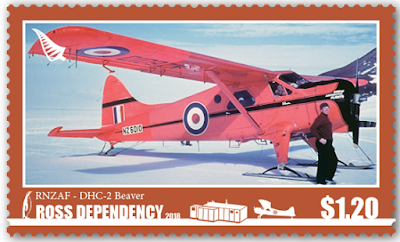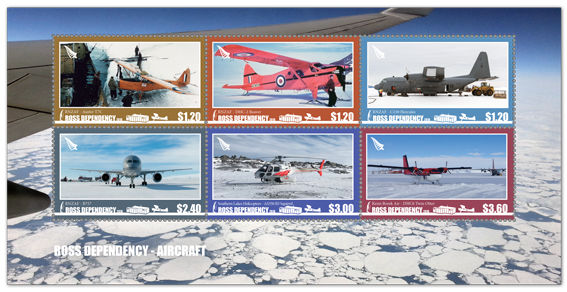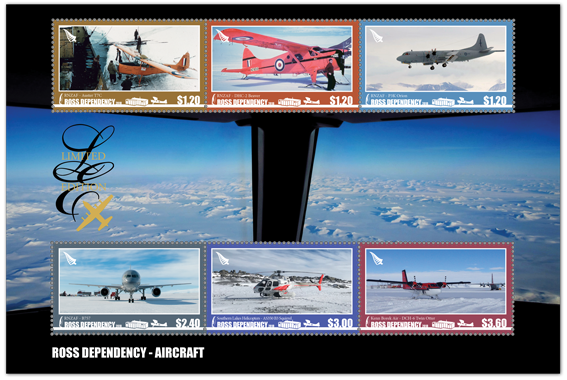 Throughout New Zealand’s Antarctic presence, aircraft have provided transport both to and across the icy continent. Land and sea-based alternatives are highly time consuming or unsafe. Much of Antarctica’s surface is covered by crevassed ice and coastal areas by seasonal sea ice.
The basic principles of Antarctic aircraft operations haven’t changed much in their 60-year history. First is the connection between New Zealand and Antarctica and second is the support of operations within Antarctica.
Transport from New Zealand is provided by the RNZAF (New Zealand Air Force) using the Lockheed C130 Hercules and more recently the Boeing 757. USA aircraft also provide assistance in this connection with both the USA and NZ aircraft flying out of Christchurch.
Science teams based in Antarctica rely on the collective capability of the aircraft type and their crews to reach areas not easily accessible by other modes of transport. Whilst technological advances assist in navigation, aircraft reliability and weather forecasting, Antarctica remains a demanding and unpredictable environment in which to operate. Without aircraft for transport, the important scientific research localities of Antarctica would be practically inaccessible.
Throughout New Zealand’s Antarctic presence, aircraft have provided transport both to and across the icy continent. Land and sea-based alternatives are highly time consuming or unsafe. Much of Antarctica’s surface is covered by crevassed ice and coastal areas by seasonal sea ice.
The basic principles of Antarctic aircraft operations haven’t changed much in their 60-year history. First is the connection between New Zealand and Antarctica and second is the support of operations within Antarctica.
Transport from New Zealand is provided by the RNZAF (New Zealand Air Force) using the Lockheed C130 Hercules and more recently the Boeing 757. USA aircraft also provide assistance in this connection with both the USA and NZ aircraft flying out of Christchurch.
Science teams based in Antarctica rely on the collective capability of the aircraft type and their crews to reach areas not easily accessible by other modes of transport. Whilst technological advances assist in navigation, aircraft reliability and weather forecasting, Antarctica remains a demanding and unpredictable environment in which to operate. Without aircraft for transport, the important scientific research localities of Antarctica would be practically inaccessible.
This issue of six stamps tells the story of New Zealand's aviation in the Ross Dependency.
Six stamps with great large photographs. It has inspired our thematic editor to do a post on Aviation in the Ross Dependency.
(Look out for this collection soon.)
The Stamps.
$1.20 - RNZAF - Auster T7C.
The Auster T7C was a British designed and built aircraft, developed in 1945 as an observation aircraft. The Auster, operated by the RNZAF Antarctic Flight as NZ1707, was powered by the wartime de Havilland Gipsy engine, and fitted with snow skis and extensive communication equipment. The design featured excellent visibility, low flying speed and short take-off capability, making it well suited for the Trans-Antarctic Expedition as the observation and reconnaissance aircraft.
There is an interesting design fault on the Auster T7c stamp – the original photograph has been used in reverse! This can be seen in the aircraft serial on the tail: WE600 – the letters and numbers are a mirror image. We also understand that WE600 is not, in fact, a New Zealand RNZAF aeroplane at all, rather it is a British RAF plane.
$1.20 - RNZAF - C130 Hercules.
The Lockheed C130 Hercules is one of the most successful cargo aircraft manufactured, with a production run spanning over 60 years. The Royal New Zealand Air Force has operated the C130 ‘H’ series since 1965. In that same year, it started supporting New Zealand’s Antarctic programme, a faultless period of service surpassing any other aircraft type on the continent. The C130 is well suited to providing the airlink from New Zealand to Antarctica, given its designed capability to operate on unprepared runway surfaces, and transport both bulk cargo and personnel.
$1.20 - RNZAF – DHC-2 Beaver.
The de Havilland Canada DHC-2 Beaver was designed as a bush aircraft to access remote North America, on floats, wheels or snow skis, and is powered by the wartime Pratt & Whitney R-985 Wasp radial engine. Operated by the RNZAF Antarctic Flight as NZ6001, the Beaver was the primary expedition aircraft for the Trans-Antarctic Expedition, laying depots of supplies and dog teams. Following the Trans-Antarctic Expedition, the Beaver continued its support of the then established New Zealand Antarctic Research Programme, now as NZ6010. In early 1960, Beaver NZ6010 crashed whilst negotiating whiteout on the Beardmore Glacier, fortunately without loss of life following a heroic rescue by the Auster. The badly damaged aircraft was not recovered.
$2.40 - RNZAF - B757.
The Boeing 757 is the Royal New Zealand Air Force’s strategic airlift aircraft, with its origins as a commercial airliner. The B757 is known for its high power-to-weight ratio and excellent takeoff performance compared with similarly sized aircraft. It supports the intercontinental link from Christchurch, New Zealand, with its ability to move large numbers of personnel in relative comfort, subsequently allowing more focused movement of cargo on the C-17 and C-130 aircraft. The B757 is one of a few commercial airliner aircraft routinely landing on an ice runway.
$3.00 - Southern Lakes Helicopters - AS350-B3 Squirrel.
The AS350-B3 helicopter, within the Squirrel series, is a French-built aircraft with a single turbine engine known for its excellent performance and resilient rigid rotor system. The Squirrel has a long and proven history of operating in the most extreme of environments around the world, particularly in mountainous locations. The B3 model, operated by the contracted operator Southern Lakes Helicopters, is highly active during the operational season, supporting the establishment of camps, personnel movements, aerial monitoring and surveillance, and search and rescue duties. The contracted helicopters supporting the New Zealand programme are transported to Antarctica seasonally by the C-17 aircraft.
$3.60 - Kenn Borek Air - DCH-6 Twin Otter.
The de Havilland Canada DHC-6 Twin Otter is a Canadian built bush aircraft, with its origins developed from the DHC-2 Beaver and its slightly larger counterpart the DHC-3 Otter, also well versed to Antarctic operations. The Twin Otter is powered by two Pratt and Whitney PT-6 turbine engines and features a large cabin capacity for movement of provisions and personnel into the interior of Antarctica. The Twin Otter has supported New Zealand’s Antarctic programme on lease arrangements with other Antarctic programmes, and contracts with its Canadian operator Kenn Borek Air. The Twin Otter’s position annually from the Northern Hemisphere for the summer season through South America and across the Antarctic continent, via the South Pole to Ross Island.
Collectables.
This issue came with the usual collectable items including First Day Covers, a Miniature Sheet, a Presentation Pack and a Special Limited Edition Pack.
First Day Cover - 7th November 2018.
The cover shows an aerial view of New Zealand's Scott Base with its distinctive green buildings.
The Miniature sheet above & First Day Cover below.
The background view is ice on the Ross Sea from an aircraft on final approach to ice runway of Williams Field. In the Presentation Pack below you can see such an approach to the airfield built on the Ross Ice Shelf.
2018 Ross Dependency Aircraft - Presentation Pack.
2018 Aircraft Presentation Pack.
This presentation pack includes a set of gummed stamps, a miniature sheet, and a first-day cover. Inside is the history of New Zealand’s aviation activities in Antarctica, and how it has evolved over the decades.
Notice the front cover showing cab view from an RNZAF C130 Hercules coming in over the Ross Sea.
Set of six full sheets.
2018 Ross Dependency Aircraft Limited Edition.
With this limited edition tells about the history of aviation in Antarctica, and how it supports our presence on the ice in the Ross Dependency.

John Evans wrote the text information for this special pack.
John is actively involved with the Beaver Preservation Trust, operating a Beaver aircraft decorated as the Trans-Antarctic Expedition NZ6001 Beaver. As an engineer, he has worked in Antarctica with the New Zealand Antarctic programme, supporting conservation activities on historic sites with the Antarctic Heritage Trust, and more recently, with Antarctica New Zealand on their overland traverse capability, supporting deep field science projects on the Ross Ice Shelf.
The Limited Edition First Day Cover - 7th November 2018.
A mounted set of the six stamps from this issue.
Technical information.
Date of issue: 7 November 2018.
The number of stamps: Six gummed.
Denominations: $1.20 x 3, $2.40, $3.00 & $3.60.
Stamps, miniature sheet and first-day cover design: Alan Hollows, New Zealand Post, Wellington, New Zealand.
Printer: Southern Colour Print, Dunedin, New Zealand.
The number of colours: Four process colours.
Stamp size and format: 50mm x 30mm (horizontal).
Paper type: Tullis Russell 104gsm red phosphor gummed stamp paper.
The number of stamps per sheet: 25.
Perforation gauge: 14.
Special blocks: Plate/Imprint blocks may be obtained by purchasing at least six stamps from a sheet. Barcode blocks are available in A and B formats.
Period of sale: Unless stocks are exhausted earlier, these stamps will remain on sale until 6 November 2019. First-day covers will remain on sale until 14 January 2019.
Information & images for this post came from.















Comments
Post a Comment
We appreciate your engagement with our content. To ensure a respectful and constructive community, please take note of the following:
- No Spam, Please: We do not tolerate spammy or promotional comments. Any such comments will be promptly removed.
- Moderation in Place: All comments are moderated to maintain a positive and inclusive environment. Please be patient, as it may take a little time for your comment to appear.
- Sign In with Google: To comment, please sign in using your Google account. This helps us maintain the integrity of our community and allows for better interaction.